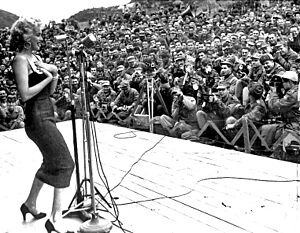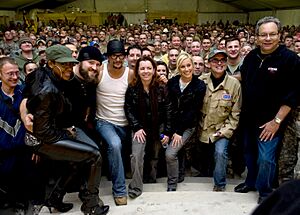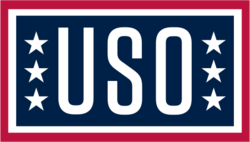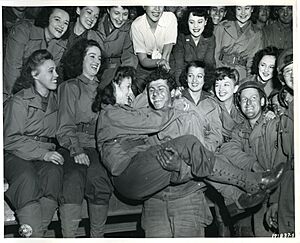United Service Organizations facts for kids
The United Service Organizations Inc. (USO) is an American group that helps members of the United States Armed Forces and their families. It's a non-profit, meaning it doesn't aim to make money. The USO offers fun shows with comedians, actors, and musicians. It also provides places for service members to relax and other helpful programs.
Since 1941, the USO has worked closely with the US government, like the Department of Defense. Most of its funding comes from donations from people and companies. Even though the government officially recognized it, the USO is not a government agency.
The USO started during World War II. Its goal was to be a "home away from home" for soldiers. It began a tradition of entertaining troops and offering social places. Many people, almost 1.5 million, volunteered to help the war effort through the USO. The USO stopped for a short time in 1947 but started again in 1950 for the Korean War. It has continued to help military members ever since, even during peacetime. During the Vietnam War, some USO centers were even in combat zones.
The organization is famous for its live shows, called "camp shows." These shows bring entertainers to boost the spirits of service members. Early on, many Hollywood stars volunteered to perform. Today, celebrities still visit military bases in the U.S. and overseas. Sometimes, they even put themselves in danger by traveling to risky areas. In 2011, the USO received the National Medal of Arts for its work.
The USO has over 200 locations around the world. These centers are in 14 countries (including the U.S.) and 27 states. In 2016, a leader of the USO, retired Army Gen. George W. Casey Jr., said that the USO has helped more than 35 million Americans throughout its history.
Contents
How the USO Started and What It Does
Why the USO Was Created

The USO was created on February 4, 1941. President Franklin D. Roosevelt asked for a group to provide fun and comfort to U.S. military members. Roosevelt became its honorary chairman. Six different groups joined together to form the USO. These included the Salvation Army, YMCA, and Young Women's Christian Association. They worked as one team to support the troops, instead of working separately as some had done before.
President Roosevelt wanted these private groups to handle activities for service members when they were not on duty. A historian named Emily Yellin explained that the government built the buildings. Then, the USO raised money from private donations to help military morale.
The first national fundraising leader was Thomas E. Dewey, who raised $16 million in the first year. The USO officially became a non-profit in New York on February 4, 1941. The first USO center opened in DeRidder, Louisiana, in 1941. More USO centers and clubs opened worldwide. They became a "Home Away from Home" for soldiers. These clubs were places for dances, movies, music, or a quiet spot to write letters. They even offered free coffee and eggs.
The USO also brought Hollywood stars and volunteer entertainers to perform for the troops. Movie historian Steven Cohan said that these shows reminded soldiers of home. They helped soldiers feel proud of America through popular entertainment. An article in Look magazine said that for a short time, the shows took the men "straight to the familiar Main Street that is the goal of every fighting American far away from home."
In 2011, President Barack Obama gave the USO the National Medal of Arts. This award was for "lifting the spirits of America's troops and their families through the arts."
The USO During World War II
After the USO started in 1941, many centers quickly opened. They were in churches, barns, and even castles. Most centers offered fun activities like dances and movies. They also had the famous free coffee and doughnuts. Some USO centers were quiet places to relax or write letters. Others offered spiritual guidance or childcare for military wives.
But the USO became most famous for its live shows, called Camp Shows. These shows helped boost the spirits of service members. USO Camp Shows, Inc. began in October 1941. By that winter, there were 186 military theaters in the United States. Overseas shows started in November 1941 with a tour of the Caribbean.
One of the first shows, called "The Flying Showboat," toured U.S. military bases in the Caribbean. It included comedians Chico Marx, Laurel and Hardy, and dancer Ray Bolger. These stars performed in very difficult conditions. The weather was hot, and many camps were not set up for shows. Even so, the shows brought loud cheers from the troops. They were happy that anyone had come to perform for them.
Within five months, 36 overseas groups had been sent to places like the United Kingdom and Australia. By 1942, 1,000 performers were part of 70 groups. Regular performers were paid $100 a week. Top stars were paid $10 a day because they were already wealthy and wanted to help.
After the Invasion of Normandy on June 6, 1944, Edward G. Robinson was the first movie star to go to Normandy to entertain the troops. He had already helped sell war bonds and gave $100,000 to the USO. During his show, he said it was the most special moment of his life to be with the soldiers. The next month, Camp Shows began in Normandy.
At its busiest in 1944, the USO had over 3,000 clubs. USO shows were happening 700 times a day. War reporter Quentin Reynolds wrote in 1943 that entertainment was very important for soldiers. He said, "You don't know what entertainment means to the guys who do the fighting until you've been up there with the men yourself."

Between 1941 and 1945, the USO put on 293,738 performances in 208,178 separate visits. It's estimated that over 161 million service members, both in the U.S. and overseas, were entertained. The USO also performed in military hospitals. They entertained over 3 million wounded soldiers in 192 different hospitals. There were 702 different USO groups that traveled the world. Some spent up to six months on tour.
Sadly, 28 performers died during their tours. Some died in plane crashes, from illness, or diseases they caught while traveling. In 1943, a plane carrying a USO group crashed near Lisbon. Singer Tamara Drasin died, and Broadway singer Jane Froman was badly hurt. Froman returned to Europe on crutches in 1945 to entertain the troops again. Her story was later made into a movie.
By the end of the war, the USO was the biggest entertainment effort American show business had ever done. The audience was millions of American fighting men, and the shows were all over the world. Performances continued even after the war ended in 1945. The USO officially closed in December 1947.
In 1991, 20th Century Fox made the film For the Boys. It told the story of two USO performers and starred Bette Midler and James Caan. The movie covered 50 years, from the USO's start in 1941 to the Operation Desert Storm in 1991.
Women's Roles in the USO
Many important volunteers for the USO were women. They were in charge of providing friendly fun for U.S. troops, who were mostly young men. USO centers around the world asked female volunteers to serve doughnuts, dance, and talk with the troops. A USO historian, Julia Carson, wrote that this "nostalgic hour" was meant to cheer soldiers. It involved "listening to music – American style" and "looking at pretty girls, like no other pretty girls in the world – American girls."
African-American women also worked hard to support soldiers and create programs for them. By 1946, hostesses served over two thousand soldiers a day. They also provided facilities for wounded soldiers on leave. They worked to combine black and white USOs into one integrated unit. As historian Megan Shockley noted, "Their work for the desegregation of USOs had begun during World War II, and it finally paid off."
Women were also key entertainers in the shows. Stars like Marlene Dietrich, Judy Garland, Betty Grable, and Rita Hayworth traveled over a million miles. On one tour, Hayworth visited six camps and signed thousands of autographs. She came back from Texas with a "nervous breakdown from over-enthusiasm!" Opera singer Lily Pons performed a serious opera song for troops in Burma. She was amazed by the applause that followed.
Author Joeie Dee said that for women entertainers, traveling with the USO allowed them to be patriots, adventurers, and professionals. However, she added that soldiers often saw these women as reminders of their girlfriends back home. They were seen as a reward for fighting and as symbols of what they were fighting for. Edward Skvarna remembered meeting Donna Reed at a USO canteen in 1943. He said, "I had never danced with a celebrity before, so I felt delighted, privileged even, to meet her. ... But I really felt she was like a girl from back home."
Like much of American society and its military during World War II, USOs were separated by race. In Riverside, California, a Negro USO was set up for African-American service members. Celebrities like Clarence Muse visited this USO.
Challenges for Women Entertainers
One female entertainer wrote about the tough conditions while performing: "We've played to audiences, many of them ankle deep in mud, huddled under the ponchos in the pouring rain... We've played on uncovered stages, when we, as well as the audience, got rain-soaked. We've played with huge tropical bugs flying in our hair and faces..."
Singer-actress-dancer Ann Miller described performing for badly wounded soldiers. She did 48 shows for "broken soldiers" who were mostly lying on stretchers. She sang and danced to try and boost their spirits. Miller said, "It was just hell... I just fell apart and I think the shock of seeing those men with their arms and legs blown off – it was just frightening."
The USO During the Korean War

In 1947, the USO stopped operating, partly because it ran out of money. But in 1951, when the United States entered the Korean War, the Secretary of Defense asked for the USO to start up again. This was to support the men and women in the armed forces with help from the American people. A historian, Paul Edwards, said that between 1952 and 1953, the USO provided services every day somewhere in Korea.
Many stars, both famous and new, came to perform. These included Bob Hope, Errol Flynn, Debbie Reynolds, Marilyn Monroe, Danny Kaye, and Al Jolson. Jolson was the first to volunteer, and he even paid for his own trip to Korea because the USO didn't have enough money.

Veterans often remember the USO events very clearly. One veteran recalled a show with Danny Kaye: "On that cold, overcast day, there were more than five thousand troops in the audience... When everyone was settled, Danny Kaye opened the show by going to the microphone... and shouting, 'Who's holding back the enemy?' The GIs roared with laughter."
Author Linda Granfield wrote that for two hours, the men could forget they were soldiers at war. After the show, they returned to the fighting. By the end of the war, over 113,000 American USO volunteers were working at 294 centers. And 126 groups had given 5,422 performances to service members in Korea and wounded soldiers in Japan.
The USO During the Vietnam War
The USO was in Vietnam even before the first combat troops arrived. The first USO club opened in Saigon in April 1963. The 23 centers in Vietnam and Thailand served up to a million service members each month. The USO put on over 5,000 performances during the Vietnam War. Stars like John Wayne, Ann-Margret, Sammy Davis Jr., Martha Raye, and Bob Hope performed. Philip Ahn, the first actor of Korean descent to become a Hollywood star, was the first Asian American USO performer to entertain troops in Vietnam.

The USO also ran centers at major U.S. airports. These centers provided a place for American service members to rest between flights. Vietnam historian James Westheider noted that the USO "tried to bring a little America to Vietnam." Volunteer American civilians, who served for 18 months, staffed the clubs. Each club had a snack bar, gift shops, a barbershop, phone lines, and hot showers.
The USO worked hard to bring famous stars from home to help relieve the stress of war. Senator John Kerry remembered how important these shows were. He recalled a "Bob Hope Follies" USO show that included actress Ann-Margret. For soldiers who saw the show, it was worth it. "We turned to watch Ann perform, and for about two minutes of American beauty, the war was forgotten."
The visits by the stars meant a lot to the men and women in Vietnam. Westheider writes, "It was not just the entertainment; it meant that they were not forgotten that far away from home." Singer and actress Connie Stevens remembered her 1969 tour with Bob Hope. Today, she says that "veterans were still stopping her and thanking her for visiting Vietnam over 30 years later."
The USO During the Gulf War
To support troops in Operation Desert Shield, USO centers opened in Saudi Arabia. Entertainers who performed for the troops included Bob Hope, Jay Leno, Steve Martin, Ann Jillian, Marie Osmond, and the Pointer Sisters. This was Bob Hope's final USO tour.
The USO in Afghanistan and Iraq
To support troops in Operations Enduring Freedom and Iraqi Freedom, USO centers opened in Afghanistan, Iraq, Kuwait, and Qatar. The USO now has over 160 centers worldwide. In recent years, new centers opened at military bases like Fort Campbell, Kentucky, and in Afghanistan.
The USO offers many programs and services. These include orientation programs, family events, free Internet and email, free phone calls home, and recreation services. One new program, "USO in a Box," sends supplies like DVD players, videos, and musical instruments to remote bases in Afghanistan.
U.S. military personnel and their families visit USO centers more than eight million times each year.

Actor Bruce Willis visited Baghdad, Camp Kir Kush, and Camp Caldwell in Iraq around December 2003. He visited military bases during his trip.
From June 8 to 11, 2009, TV personality Stephen Colbert traveled to Iraq. He filmed his show The Colbert Report there for four days as part of a USO-sponsored event.
Other entertainers who have performed in the Middle East include Al Franken (who made six USO tours), Robin Williams, Craig Ferguson, Gary Sinise, Zac Brown, Five Finger Death Punch, Jessica Simpson, Carrie Underwood, Toby Keith, Kellie Pickler, and Lewis Black.
The USO has also helped with the annual "Tribute to the Troops" special for World Wrestling Entertainment. They have aired WWE RAW from Afghanistan and Iraq every Christmas in the United States.
What Services Does the USO Provide?
The USO helps troops before, during, and after their deployments. It does this through staffed and unstaffed USO centers, even in combat zones.
Operation Phone Home
USO centers in combat zones offer free phone calls home and internet access to service members. They use their own private telephone network and high-speed internet.
Bob Hope Legacy Reading Program
This program lets service members record themselves reading a book. They can then send the video to their children at home.
USO Care Package Program
The USO sends care packages to service members. These packages include travel-sized hygiene products, healthy snacks, and drink mixes. In 2019, 170,000 hygiene packages were sent. During the COVID-19 pandemic, the USO put together thousands of care packages for troops in quarantine on their way home.
USO Special Delivery
The USO hosts baby showers for military parents-to-be. These baby showers help pregnant military spouses connect and form a community while their partners are deployed.
USO2GO
USO2GO provides special kits to military service members in areas without a USO Center. These kits can be customized and contain toiletries, snacks, furniture, electronics, or anything else they might need. Since 2008, the USO has sent over 2,000 kits to places like Afghanistan, Iraq, and Egypt.
Entertainment
The USO has hosted more than 8.1 million celebrity visits at its centers worldwide.
Honoring Bob Hope
In 1997, the U.S. Congress honored Bob Hope. They called him the "first and only honorary veteran of the U.S. armed forces." Hope was famous for traveling millions of miles to entertain soldiers during both wartime and peace. His work with the USO began in 1941 and ended with Operation Desert Shield in 1991. He spent 48 Christmases overseas with American service personnel. He was always seen as a great help to the U.S. Government because he was always willing to entertain when needed. After World War II ended, the USO asked entertainers not to forget the soldiers. Hope was one of the first to say yes.
Because of his constant entertainment for both civilians and the military, he received many other honors. A C-17 Air Force plane was named The Spirit of Bob Hope. A naval ship was named the USNS Bob Hope. Streets, schools, hospitals, and a golf tournament were also named after him. The Guinness Book of Records called him the most honored entertainer ever. In 1993, when he turned 90, General Colin Powell praised Hope for his tireless USO tours.
War reporter Quentin Reynolds wrote in 1943 that Hope and his group would travel 300 miles in a jeep and give four shows. One general said Hope was worth a division of soldiers, about 15,000 men. This meant he was a very important target.
During the Vietnam War, Hope made many popular television specials. He felt that the U.S. media supported his work in Vietnam. After his Christmas show in Saigon in 1967, he learned that the Viet Cong had planned an attack on the hotel where his group was staying. They missed them by ten minutes. Hope later wrote that he was upset by people in America who were burning their draft cards. He wrote, "Can you imagine, that people in America are burning their draft cards to show their opposition and that some of them are actually rooting for your defeat?" In 1973, Hope wrote his fifth book, The Last Christmas Show. He gave all the money from the book to the USO.
His final Christmas show was during Operation Desert Shield in 1990. This show was difficult. Hope's jokes were checked by the State Department to avoid offending the Saudis. Also, the media was not allowed to cover the shows. Because women in Saudi Arabia must be veiled in public, Ann Jillian, Marie Osmond, and the Pointer Sisters were not part of Hope's Christmas Eve show.
In 2009, Stephen Colbert ended his week of filming in Iraq for his The Colbert Report show. He carried a golf club on stage and dedicated it to Bob Hope's service for the USO.
How the USO Is Organized
The USO has about 800 paid staff members. In addition, over 44,000 USO volunteers give an estimated 371,417 hours of service each year. The USO reports that for every paid employee overseas, there are 20 unpaid volunteers. In the United States, the number of volunteers per employee is even higher.
The organization Charity Navigator gave the United Service Organizations a 3-star overall rating. It received a 2-star financial rating and a 4-star rating for how accountable and transparent it is.
See also
 In Spanish: United Service Organizations para niños
In Spanish: United Service Organizations para niños
- Gilla Gerzon (Former director, USO Haifa)
- Entertainments National Service Association (ENSA), an organisation established to provide entertainment for British armed forces personnel during World War II





